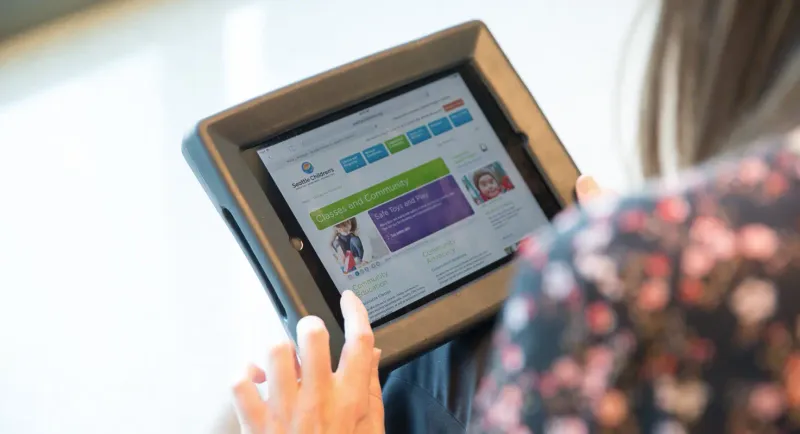As the pediatric and adolescent academic medical center for Washington, Alaska, Montana and Idaho, Seattle Children’s is dedicated to serving the region’s most vulnerable residents through industry-leading healthcare. But their offering is even greater than first meets the eye. Seattle Children’s was the first pediatric hospital in the country to provide its patients with a unique offering – iPads for Kids.
Making the unimaginable possible
When first approached by The Bungie Foundation about their offer to provide an entertainment program to Seattle Children’s patients, at no cost to the hospital, those involved in the conversation were skeptical. It was difficult to understand why Bungie, a video game developer, would want to join the healthcare space. “Everyone wanted to know the catch,” said Christine Edwards, senior foundation manager, The Bungie Foundation.
Edwards met with hospital leaders, IT personnel and various care team staff to discuss patient privacy, device security, staff workload and more. “I told them we all have the same goal, and that’s to create the best patient experience for their kiddos,” she said. After nearly a year of planning and preparation, in 2012, The Bungie Foundation kicked off iPads for Kids with an implementation of approximately 30 iPad devices at Seattle Children’s.
The biggest thing for us is that it’s an example of how we can provide healthcare differently for kids. We can attend to their sickness and attend to their wellness at the same time.
Implementing the vision
The program started strong. All the devices saw continual use, and additional departments asked for expansion to their areas. But device deployment remained tricky. At the time, when a nurse or Child Life Specialist needed an iPad for their patient, they submitted a request. The program coordinator then began a lengthy setup process that included factory resetting the device, going to the App Store and individually selecting 60 age-appropriate apps for the patient.
“It was a really time-intensive process that could take hours, and then the patient may not get it for a full day, depending on how their schedule changed throughout the day,” said Austin Schlichtman, program specialist, The Bungie Foundation. The Bungie Foundation knew that in order to best serve kids at Seattle Children’s, something had to change. They reached out to Apple for advice.
“They told us, ‘Jamf is going to have exactly what you need out of the box, and it’s just going to work. Give them a call.’ So we did,” Edwards said. They began using Jamf Pro and everything changed. “Now when I receive a request, I just go in and select an age group, instead of having to go in, track apps down and load them individually,” Schlichtman explained. What used to take an hour is now complete in minutes.
A faster, more strategic process means iPads for Kids creates better hospital experiences for more children by giving them a device with pre-populated, age-appropriate content to use during their stay. Schlichtman estimates he receives an average of eight iPad requests each day. And while that number may seem small, “Each one is usually a nurse calling, wanting an iPad for their patient for distraction,” he explained. “So being able to utilize Jamf Pro to get a device out in 10 minutes is a life saver.”
Jamf remotely wipes each device and resets it to factory settings every time a patient leaves the hospital, an action that allows The Bungie Foundation to provide imperative security for Seattle Children’s patients. “It’s really important that we’re able to wipe everything off. The protected health information (PHI) of the patients is something that can’t be shared,” said Debbie Kruse, director of Patient Support Services at Seattle Children’s.
The power of distraction
The iPad devices see many different uses throughout the day. For patients, they are an enjoyable distraction as they undergo simple procedures like blood draws. Schlichtman said playing popular games like Minecraft, and watching their favorite videos on YouTube or Netflix, are instrumental in helping kids have a more pleasant experience while in the hospital. But senior director for Patient and Family Experience at Seattle Children’s, Laura Crooks, said the devices have a more profound impact on certain patient populations.
In the rehabilitation unit, for instance, Crooks said kids stay an average of 22 to 24 days. Even though they have a variety of physical challenges, the technology gives those children the ability to interact with the smallest touch of a screen or simple head movements. “To have parents see their child do that gives them hope,” Crooks said. “It gives parents a way to interact with their kids that’s not all about how sick they are.”
As an added benefit, Kruse said the iPads for Kids program doesn’t add any burden to the care teams’ busy schedules. “It definitely makes them easier,” she said. “The Child Life Specialists can’t be everywhere every minute that they’re here, and that iPad helps the child cope during a situation where a Child Life Specialist might not be present.”
The partnership with Bungie was amazing. They listened to the needs of the hospital, the challenges, the limitations we have and the really fragile population we serve. And they were able to incorporate that into a pilot program that has since blossomed into something huge and incredible.
Enhancing parent and caregiver interactions
Pediatrician and Chief of Digital Innovation, Dr. Wendy Sue Swanson leverages the wisdom of clinicians, patients and researchers to transform healthcare delivery in the digital age. She said using the iPad as a means of delivering patient education prior to meeting with nurses, doctors and social workers dramatically enhances the quality of those interactions. “The conversations can start in a very different place,” she said. “The families have had time to review and dig into more of the content.”
Swanson said providing families with information before they meet with members of the care team is especially helpful when it comes to understanding their child’s medications. She explained that pharmacists used to spend an average of six to 12 hours at the bedside with some organ-transplant patients. Much of this time focused on helping the families understand how the medications work. Now, she said, they clock an average of only one to two hours at the bedside, because the families already had an opportunity to review the materials.
“The experience of the inpatient can really dramatically change by that very perishable time we get together.” She added, “The hope is that we can do some seeding for patients and families to feel more in control and be more expert in a conversation that they care so much about.”
Swanson said providing information digitally will continue to expand an effort to create better experiences for patients, families and care teams. “We want to be everything we’ve always been – good listeners, empathetic experts at the bedside – but we think some of that redundant stuff, the things we say over and over again to each patient, can get captured in digital media.”
Bungie and The Bungie Foundation have been a dream team. They really understand the challenges and limitations in a hospital setting, especially a pediatric hospital setting.
Doing the right thing
Though they hesitated when The Bungie Foundation first introduced the iPads for Kids program, caregivers at Seattle Children’s now see the program as highly beneficial to the patient’s experience. “If we can support our patients and our families, and we can support our staff and providers while providing an experience where patients wouldn’t want to go anywhere else, then we’ve really done the right thing.” Crooks said.
Kruse mirrored her sentiment saying, “It’s a great program, and it really feels like there’s a lot of thought and effort put into it. And I feel Bungie, too, really believes this is an effective program. It feels really good to have somebody who’s behind the program 100 percent, and they’re supporting us the whole time.”



